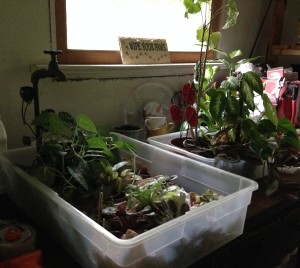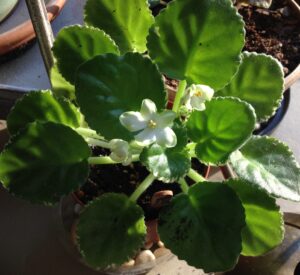Originally published on December 17, 2015, when my dear Mom was in a nursing home.
Hello, fellow readers, “You can’t water their faces,” recalls brother Rick, one of Mom’s instructions on caring for African violets, as water on their leaves can cause spotting damage. Mom had quite a collection of violets when we were kids. As I write, we are visiting her in a nursing home in Virginia. A few months back, my sister asked that I adopt Mom’s African violets collected during the years she lived with her. Dorothy cherished taking Mom to the annual African Violet Festival nearby.
How to Care for African Violets
As you would guess, African Violets, Saintpaulias, are native to Africa. They need plenty of indirect sunlight; hence, west or south windows are best. Use sheer curtains or adjust the blinds to filter the light. Rotate plants a quarter turn weekly so they don’t bend towards the light. Keep their soil moist, never soggy, and water only when the soil’s top feels dry. The water should be at room temperature as cool water will cause their leaves to curl. Mom always used a charming brass watering can that she filled and left next to her babies for the next time she watered.
The option of Grow Lights
If you opt for grow lights, remember that African Violets need at least eight hours of darkness daily to bloom. And beware of leaf bleaching – leaves that are lighter or pinkish due to artificial light. The only remedy is natural sunlight.
African Violets like warmth, preferably about 70, but 60 to 80 degrees is acceptable. Less than 50 degrees is fatal to these tropical beauties. The ideal fifty percent humidity is hard to maintain in heated homes. By grouping plants, the humidity around them can increase by 15 percent. It’s essential to keep their leaves from touching; they need room to grow and air circulation to prevent disease. Containers of water around the plants can help. Or use a humidifier during the winter. Another way is to elevate the plants on pebbles kept moist. Be sure the water level stays clear of the bottoms of the pots.
All this may sound fussy, but African Violets are adaptable and are popular houseplants. One of Mom’s treasures is back in bloom. Her dark green leaves have creamy white edges complimented by cream-colored flowers edged with pale green. She’s ‘Frozen in Time,’ which is fitting. While all flowers fade, our memories are forever frozen in time.
Garden Dilemmas? AskMaryStone@gmail.com (and now on your favorite Podcast App.)
More about violets and a tribute to my dear Mom, who always Preferred Roots
There’s more to the story in the Garden Dilemmas Podcast:
A link to the African Violet Society of America’s website: www.avsa.org.
More about violets and a tribute to my dear Mom, who always Preferred Roots and the sequel story, Fixing African Violets with Long Stems




